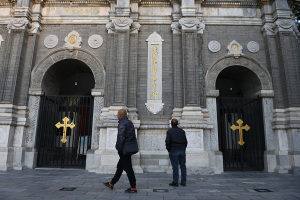Henry Poole is Here
4 Stars – Uplifting
A world in which miracles are not possible is a world without hope. That truth was expressed by Dante in the 1300's when he suggested that the inscription to the entrance of hell would proclaim that a person will "abandon all hope" by entering there. That the loss of hope often puts a person into a hell-on-earth is compellingly presented by Mark Pellington (Arlington Road) in his intriguing film "Henry Poole Is Here."
Written by Albert Torres, the tale is part parable and part practical theology. The parable comes through in its obvious plot and use of names. The practical theology is presented by the characters as they struggle with faith and doubt, not only as they face the difficulties of life but also the possibility of divine intervention.
The plot centers on Henry Poole (Luke Wilson) who has been given the news that he has a hopeless terminal illness. Distraught, he returns to the neighborhood of his childhood. Unable to purchase his family house, Poole purchases a rundown house down the street and decides to spend his last days eating Krispy Kreme donuts and drinking vodka. Pulling the shades and slipping into the darkness of his hopelessness, he does not realize that he is about to be asked to confront his lack of faith and hope.
The character who represents this confrontation is his next door neighbor Esperanza (Adriana Barraza), whose name means hope in Spanish. Coming to visit to welcome Poole to their neighborhood, Esperanza explains that she was close to the man who lived in the house before Henry moved in and she is grieving his death. When she sees an unusual marking in the new stucco recently applied to the house, she is convinced that it is the face of Christ and expects the shrine this becomes to give miraculous assistance to all who believe.
This offer of divine hope by Esperanza is compounded by the offer of hope for human love from his next door neighbor on the other side of the house. Dawn Stupek (Radha Mitchell) and her daughter Millie (Morgan Lily) have their own sorrows. Having been left by Dawn's husband and Millie's father, both of them are withdrawn and Millie has retreated into an autistic-form of grief in which she has not spoken since her father left. But when she believes that touching the face of Christ can relieve her suffering, she visits the shrine at Esperanza's invitation and is healed.
Poole rejects the notion but as more miracles occur, the closed world of his hopeless condition is cracked open. It is this predictable opening of his heart that is the point of the parable and the center of the theological lesson. That it is not easy for him to open his heart to hope is also part of this tale.
As the title indicates, to truly be "here" is the point of all of life. To live with hope and love allows people to be present not only to themselves and others but also with God who offers to be present with us, whether in a vision appearing on stucco or by a warming of the heart.
Discussion: 1. When you have faced a dark moment of your soul where all hope is gone, how did you respond? How did God catch your attention?
2. It is the nature of grief to withdraw from others in isolation. We see it in both Poole and Millie most dramatically. Have you ever found yourself living in isolation? How did you get out of that dark place?
3. Do you believe the Creator of the universe would stoop to being represented in stucco? Why or why not?




























